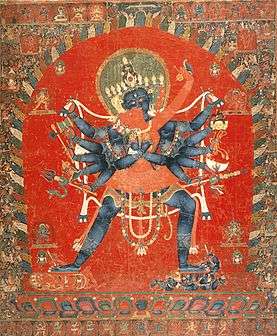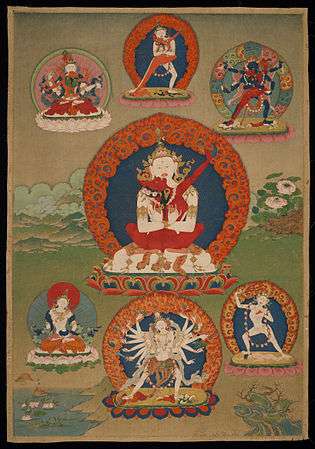Cakrasaṃvara Tantra

| Part of a series on |
| Vajrayana Buddhism |
|---|
 |
|
Traditions Historical traditions:
New branches:
|
|
History |
|
Pursuit |
|
Practices |
|
Festivals |
|
Ordination and transmission |
| Vajrayana Buddhism portal |
The Cakrasaṃvara Tantra (Sanskrit: चक्रसंवर तन्त्र) or Khorlo Déchok (Tibetan: འཁོར་ལོ་བདེ་མཆོག, Wylie: 'khor lo bde mchog ) is considered to be of the mother class of the Anuttarayoga Tantra in Vajrayana Buddhism.[1]
Deity and mandala
The central deity of the mandala, Saṃvara, is a form of Heruka, one of the principal yidam or meditational deities of the Sarma schools of Tibetan Buddhism.[2]
Saṃvara is typically depicted with a blue-coloured body, four faces, and twelve arms, and embracing his consort, the wisdom dakini Vajravārāhī in Yab-Yum. Other forms of the deity are also known with varying numbers of limbs.
Saṃvara and Vajravārāhī are not to be thought of as two different entities, as an ordinary husband and wife are two different people; in reality, their divine embrace is a metaphor for the union of great bliss and emptiness, which are one and the same essence.
In Western meditation texts his name is often translated to mean "Highest Bliss". Meditation on Cakrasaṃvara is an advanced practice transmitted by one's lama, and binds the mind of the meditator to enlightenment itself.
Influence of Saivism
The Samvara texts adopted the pitha list from the Saiva text Tantrasadbhava, introducing a copying error where a deity was mistaken for a place.[3]
Gallery
 Chakrasamvara, 18th-century painting, Rubin Museum of Art
Chakrasamvara, 18th-century painting, Rubin Museum of Art Chakrasamvara mandala, Nepalese painting from 1490
Chakrasamvara mandala, Nepalese painting from 1490
See also
Notes
- ↑ Buswell 2013.
- ↑ Gray & Yarnell 2007.
- ↑ Huber, Toni (2008). The holy land reborn : pilgrimage & the Tibetan reinvention of Buddhist India. Chicago: University of Chicago Press. pp. 94–95. ISBN 978-0-226-35648-8.
References
- Buswell, Robert Jr; Lopez, Donald S. Jr., eds. (2013). Princeton Dictionary of Buddhism. Princeton, NJ: Princeton University Press. pp. 162–163. ISBN 9780691157863.
- Gray, David B.; Yarnell, Thomas F. (2007). The Cakrasamvara Tantra: the discourse of Śrī Heruka (Śrīherukābhidhāna). American Institute of Buddhist Studies at Columbia University. ISBN 978-0-9753734-6-0.
Further reading
- Chetsang Rinpoche; Clark, Robert (tr.) (2009). The Practice Of Mahamudra. Snow Lion. ISBN 978-1559393232.
- Dharmabhadra, Dṅul-hu; Gonsalez, David (tr.) (2010). Source of Supreme Bliss: Heruka Chakrasamvara Five Deity Practice and Commentary. Snow Lion Publications. ISBN 9781559393652.
- Gray, David B. (2003). "The Chakrasamvara Tantra: The Text and Its Traditions". In Huntington, John C.; Bangdel, Dina. The Circle of Bliss: Buddhist Meditational Art. Serindia Publications. ISBN 9781932476019.
- Yeshe, Losang; Gonsalez, David (tr.). The Ecstatic Dance of Chakrasamvara: Heruka Body Mandala Practice and Commentary. Dechen Ling Press. ISBN 978-0-615-78851-7.
External links
- Sacred Visions: Early Paintings from Central Tibet, an exhibition catalog from The Metropolitan Museum of Art (fully available online as PDF), which contains material on Cakrasaṃvara Tantra (see index)
- Berzin, Alexander (February 2012). "Introduction to the Chakrasamvara System of Anuttarayoga Tantra". studybuddhism.com. Study Buddhism. Retrieved 2016-06-03.
 Media related to Chakrasamvara at Wikimedia Commons
Media related to Chakrasamvara at Wikimedia Commons